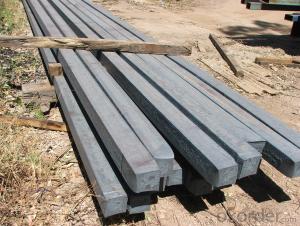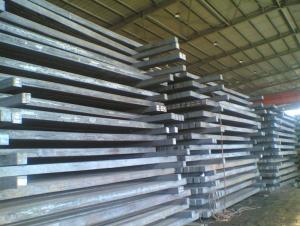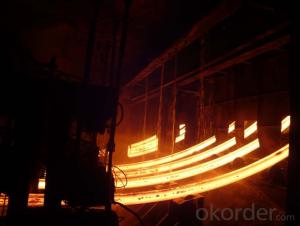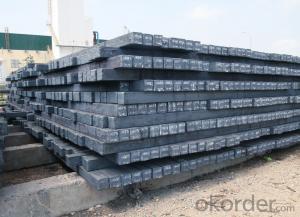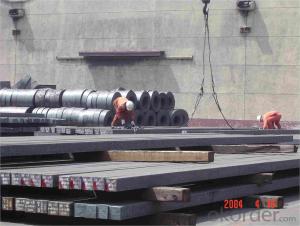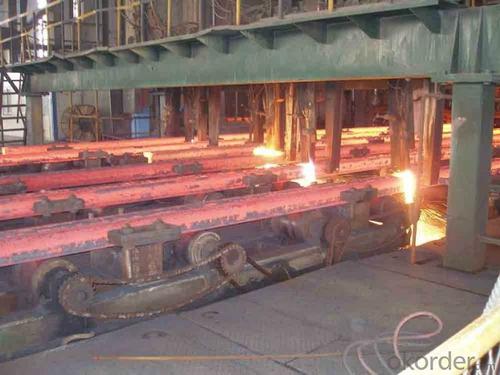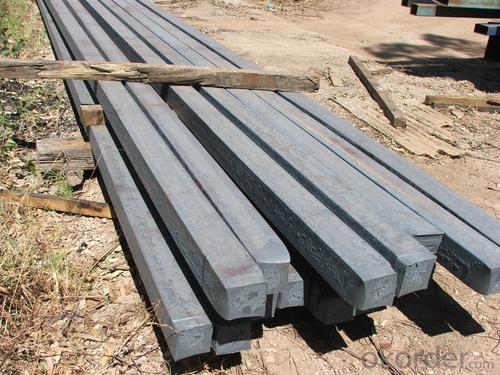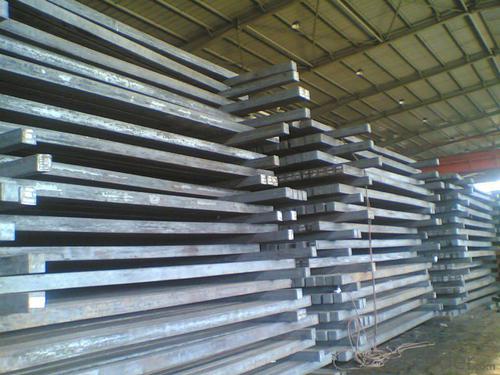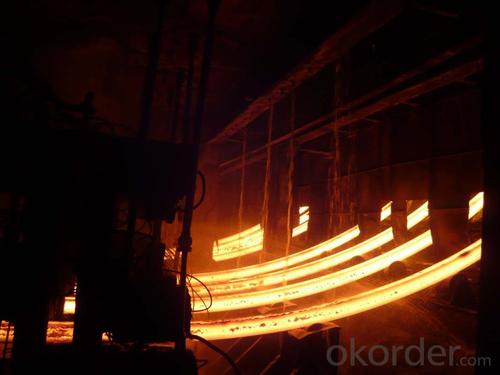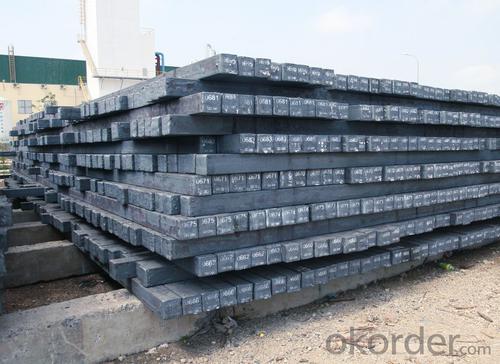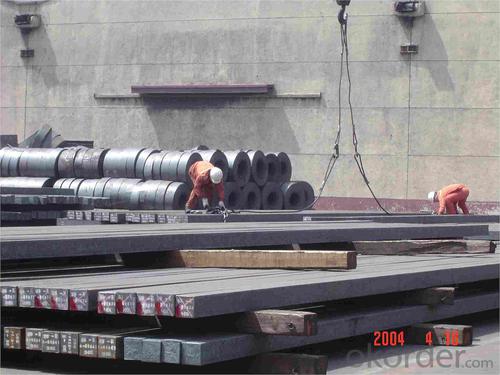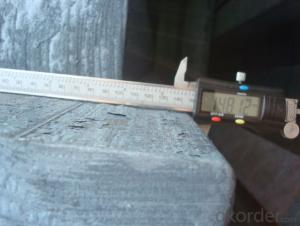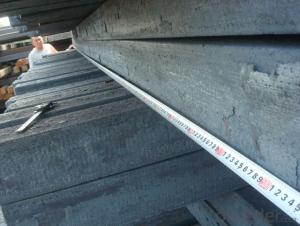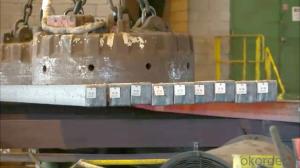Q235/3SP 165MM Blast Furnace Hot Rolled Steel Billet
- Loading Port:
- Tianjin
- Payment Terms:
- TT OR LC
- Min Order Qty:
- 2000 m.t.
- Supply Capability:
- 30000 m.t./month
OKorder Service Pledge
OKorder Financial Service
You Might Also Like
Description of Q235/3SP 165MM Blast Furnace Hot Rolled Steel Billet
Our hot dip galvanised steels consist of a steel substrate with a metallic zinc coating applied by means of a continuous hot dip galvanising process. Metallic zinc coatings are available in steel grades ranging from steel for bending and deep drawing applications, to structural steels and high yield strength steels.
A glossy surface finish obtained under specific skin-pass conditions (either non-skin-passed or skin- passed with smooth cylinders to obtain low roughness) can be provided if required at time of enquiry.
Advantage of Q235/3SP 165MM Blast Furnace Hot Rolled Steel Billet
Uncoated CR steel sheet With the features of in line with the international highest standards in demension and shape, excellent surface finish and properties, the products are mainly used in home appliance and automobile industries.
Galvanized steel sheet(include HDG and EG)
With the features of good corrosion resistance, the products are mainly used in automobile, home appliance, electronics, building and machinery manufacture industries, etc.
Precoated steel sheet With the features of enviromental protection and good processablility, long lasting surface durability, rich in colors, the products are maily used in building, home appliance and furniture industries, etc.
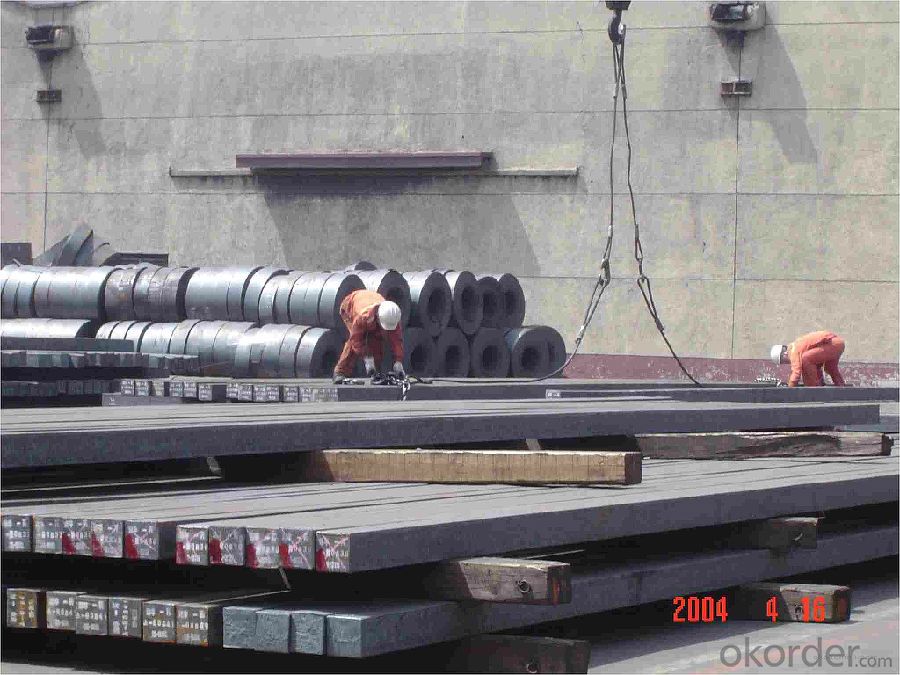
Applications of Q235/3SP 165MM Blast Furnace Hot Rolled Steel Billet
Our hot dip galvanised steels can be used in a very wide range of applications for industrial markets, both indoors and outdoors. Some of the most common applications are:
Building: wide sections for roofing and cladding, doors, door frames, metallic ceilings, partitions, structural members etc
Domestic appliances: all appliances for this sector (both white and brown goods) are manufactured with hot dip galvanised steels
Miscellaneous: electrical cabinets, aeraulic components, air conditioners, road signs etc
Zinc hot dip galvanised steel is suitable for contact with foodstuffs under certain conditions, as specified in European directive 89/109/EEC and French standard NF A 36-712-1. Please contact us for further information on this subject.
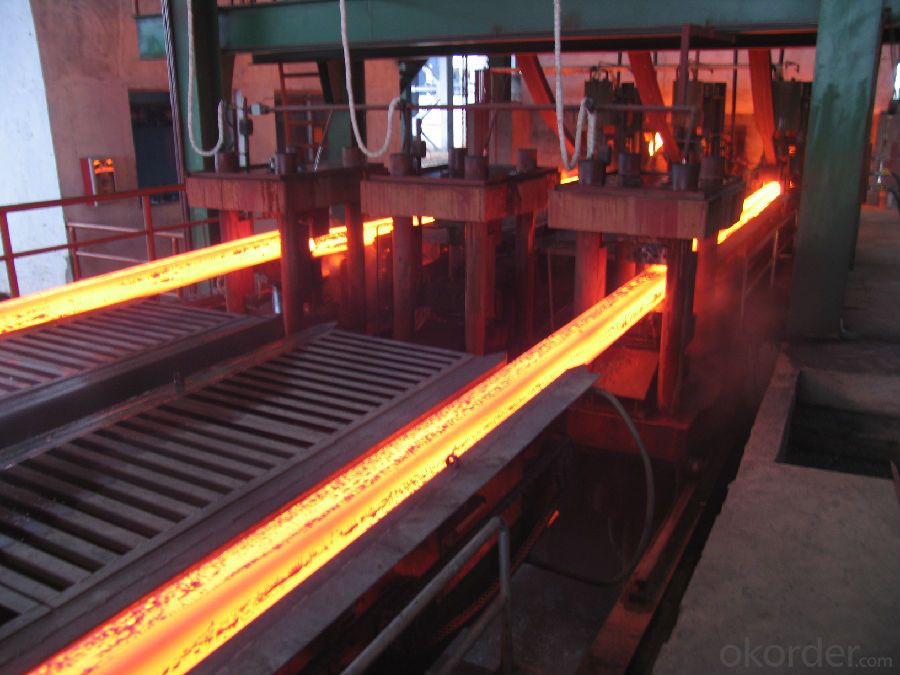
Specifications of Q235/3SP 165MM Blast Furnace Hot Rolled Steel Billet
Quality | Q/BQB 440-2003 | JIS G3312-1994 JIS G3321 | EN 10326-2004 | ASTM A653-02a |
EN 10327-2004 | (BASE PLATE) | |||
(BASE PLATE) | ||||
Commercial Steel | DC51D | SGCC SGLCC | DX51D+Z DX51D+AZ | CS Type A/B/C |
Forming Steel | St01,St02,St03 | SGCD1 SGLCD1 | FS Type A, Type B | |
Drawing | DC52D /DC53D | - | DX52D+Z DX52D+AZ | DDS TYPE A/C |
Steel | DX53D+Z DX53D+AZ | |||
Structural | S280GD (StE28) | SGC400 SGLC400 | S280D+Z DX54D+AZ | SS275 |
Steel | S350GD (StE34) | SGC440 SGLC440 | S350D+Z S350D+AZ | SS340 Class1 |
FAQ of Q235/3SP 165MM Blast Furnace Hot Rolled Steel Billet
We have organized several common questions for our clients,may help you sincerely:
1. How Can I Visit There?
Our company is located in Tianjin City, China, near Beijing. You can fly to Tianjin Airport Directly. All our clients, from home or aboard, are warmly welcome to visit us!
2. How Can I Get Some Sample?
We are honored to offer you sample.
3. Why choose CNBM?
Our delivery time about 15-20days for standard sizes, if you have other requirements like hardness, quanity and width ,it is about 20-40days. But don't worry we also try our best for the delivery time ,because time longer and our cost is higher.
- Q: How are steel billets used in the manufacturing of shafts?
- Shafts are manufactured using steel billets, which are essential components. These billets are semi-finished steel products that typically have a square or rectangular shape. They are created by pouring molten steel into molds and allowing it to solidify. When it comes to shaft manufacturing, steel billets act as the starting material. They are heated to a specific temperature to increase their malleability and ease of handling. Once heated, the billets undergo various processes like forging, rolling, or extrusion. Forging involves shaping the heated billet using a hammer or press to apply compressive forces. This process enhances the grain structure of the steel, improving its strength and minimizing internal defects. On the other hand, rolling involves passing the billet through a series of rollers to gradually shape it into the desired form. It is commonly used for producing long, cylindrical shafts. Extrusion is another technique employed in shaft manufacturing. Here, the heated billet is forced through a die under high pressure, resulting in a shaft with a specific cross-sectional shape. This method is particularly useful for creating shafts with intricate details or complex geometries. After the initial shaping process, the shafts undergo further steps like machining, heat treatment, and finishing. Machining involves removing excess material and creating specific features such as keyways or threads. Heat treatment is used to enhance the shaft's strength, hardness, and durability. In conclusion, steel billets are the raw materials used in the production of shafts. Through processes like forging, rolling, or extrusion, the billets are transformed into the desired shape, size, and properties of the shafts. This ensures that the resulting shafts are strong, reliable, and suitable for their intended applications in industries like automotive, aerospace, and machinery.
- Q: How do steel billets contribute to the construction of bridges and infrastructure?
- Steel billets play a crucial role in the construction of bridges and infrastructure due to their strength, versatility, and durability. These cylindrical bars of steel are produced through a process called casting, where molten steel is poured into molds and allowed to cool and solidify. One of the primary contributions of steel billets to bridge construction is their high load-bearing capacity. Bridges are subjected to heavy loads, such as the weight of vehicles, pedestrians, and even natural forces like wind and earthquakes. Steel billets, with their exceptional strength and structural integrity, provide the necessary support to withstand these loads and ensure the safety and stability of the bridge. Furthermore, steel billets offer flexibility in design and construction. Their malleability allows them to be easily shaped and formed into various structural components, such as beams, columns, and girders, which are essential elements in bridge construction. This flexibility enables engineers to create innovative designs and optimize the use of materials, resulting in cost-effective and efficient bridge structures. Another significant advantage of steel billets is their resistance to corrosion. Bridges are constantly exposed to harsh environmental conditions, including moisture, saltwater, and pollution. Steel billets can be treated with protective coatings or alloyed with elements such as chromium or nickel to enhance their resistance to corrosion. This ensures the longevity and durability of the bridge, reducing maintenance costs and enhancing its lifespan. Additionally, steel billets contribute to the speed of bridge construction. As these billets are prefabricated in steel mills, they can be produced in large quantities and transported to the construction site, ready for assembly. This prefabrication process reduces the time required for on-site construction, minimizing disruption to traffic and reducing overall project duration. In summary, steel billets are integral to the construction of bridges and infrastructure due to their high load-bearing capacity, flexibility in design and construction, resistance to corrosion, and contribution to faster construction times. Their contribution ensures the safety, longevity, and efficiency of bridge structures, making them an essential component in the development of robust and reliable infrastructure systems.
- Q: How do steel billets compare to other forms of raw steel material?
- Steel billets are a specific form of raw steel material that offer distinct advantages compared to other forms of steel. Firstly, steel billets are known for their high strength and durability. They are produced through a carefully controlled process that ensures a uniform composition and a consistent grain structure, resulting in superior mechanical properties. This makes steel billets ideal for applications that require strong and reliable steel, such as construction, automotive, and manufacturing industries. Furthermore, steel billets offer excellent machinability. Their regular shape and size make them easier to handle and process, reducing wastage and improving efficiency during production. This is particularly beneficial for manufacturers who rely on precision machining techniques to create intricate and complex components. Another advantage of steel billets is their versatility. They can be forged, rolled, or extruded into various shapes and sizes, allowing for customization according to specific requirements. This versatility makes steel billets suitable for a wide range of applications, from structural beams and bars to pipes and rods. Moreover, steel billets have a relatively low carbon content, which makes them more ductile compared to other forms of raw steel material. This increased ductility allows for easier shaping and forming, making steel billets particularly suitable for hot working processes like forging and rolling. In summary, steel billets offer numerous advantages compared to other forms of raw steel material. Their high strength, excellent machinability, versatility, and ductility make them a preferred choice for many industries. Whether it's for structural purposes or manufacturing complex components, steel billets provide the necessary properties and flexibility to meet a wide range of requirements.
- Q: How do steel billets contribute to the water treatment industry?
- Steel billets are used in the water treatment industry to manufacture various components such as pipes, valves, and fittings. These components are vital for the construction and maintenance of water treatment infrastructure. Steel billets provide the necessary strength, durability, and corrosion resistance needed to withstand harsh conditions and chemicals involved in water treatment processes. Thus, steel billets play a crucial role in ensuring the efficiency and longevity of water treatment systems.
- Q: What are the different types of non-destructive testing methods used for steel billets?
- Steel billets undergo various non-destructive testing methods to ensure their quality and integrity without causing any damage or alteration. Commonly used techniques include: 1. Ultrasonic Testing (UT): High-frequency sound waves are utilized to detect internal defects like cracks, voids, and inclusions that may affect the billet's performance. 2. Magnetic Particle Testing (MPT): Magnetic fields and particles are employed to identify surface and near-surface defects such as cracks and seams that may be invisible to the naked eye. 3. Eddy Current Testing (ECT): By measuring changes in electrical conductivity and magnetic fields, ECT can detect surface and near-surface defects like cracks and corrosion. 4. Visual Inspection: This basic method involves a thorough visual examination to identify visible defects such as surface cracks, dents, or irregularities. 5. Penetrant Testing (PT): A liquid or fluorescent dye is applied to the billet's surface, seeping into any surface defects. After removing excess dye and applying a developer, defects like surface cracks and porosity become visible. 6. Radiographic Testing (RT): Using X-rays or gamma rays, RT penetrates the billets to produce images revealing internal defects like cracks, inclusions, and voids. Employing a combination of these techniques, manufacturers ensure the safety and performance of steel billets by identifying and rectifying potential defects or inconsistencies.
- Q: Are steel billets recyclable?
- Steel billets can indeed be recycled. As one of the most widely recycled materials globally, steel has a well-established and remarkably efficient recycling process for its billets. When these billets reach the end of their usefulness, they can be melted and repurposed to create new steel products. By engaging in this recycling process, we not only conserve precious natural resources but also decrease energy consumption and minimize our environmental footprint. Moreover, recycling steel billets aids in diminishing landfill waste while supporting the circular economy and promoting the sustainable utilization of resources.
- Q: Are steel billets subject to any regulations or certifications?
- Yes, steel billets are subject to various regulations and certifications. These regulations and certifications ensure that the steel billets meet specific quality standards, safety requirements, and environmental regulations. Some common certifications include ISO 9001 for quality management systems, ISO 14001 for environmental management systems, and certifications from industry-specific organizations like the American Society for Testing and Materials (ASTM) or the International Organization for Standardization (ISO). Additionally, steel billets may need to comply with specific regulations in the country or region where they are produced or used, such as building codes or product safety regulations.
- Q: What are the different surface defects that can be found in steel billets?
- There are several common surface defects that can be found in steel billets. These defects can occur during the manufacturing process or due to handling and transportation. Some of the different surface defects that can be found in steel billets include: 1. Scale: Scale is a type of surface oxidation that appears as a thin layer of iron oxide on the surface of the billet. It can occur during the heating and cooling process and can be removed through mechanical or chemical cleaning methods. 2. Cracks: Cracks can occur due to the improper cooling of the billet or excessive stress during handling. They can either be longitudinal or transverse, and their severity depends on the depth and length of the crack. Cracks can weaken the structural integrity of the billet and should be carefully inspected and repaired. 3. Inclusions: Inclusions are particles or impurities that are trapped within the steel during the manufacturing process. They can be non-metallic or metallic in nature and can affect the mechanical properties of the billet. Inclusions can be categorized as slag inclusions, gas porosity, or non-metallic inclusions like oxides and sulfides. 4. Decarburization: Decarburization is a surface defect that occurs due to the loss of carbon on the surface of the billet during the heating process. It can result in reduced hardness and strength of the steel in the affected area. Decarburization can be minimized by controlling the heating and cooling process and using protective atmospheres. 5. Laminations: Laminations are layers or sheets of non-metallic material that are trapped between the layers of steel during the manufacturing process. They can cause weak spots in the billet and can lead to failure under stress. Laminations can be detected through non-destructive testing methods and should be removed or repaired. 6. Pitting: Pitting is a localized corrosion phenomenon that appears as small pits or cavities on the surface of the billet. It can occur due to exposure to corrosive environments or improper storage conditions. Pitting can reduce the lifespan of the billet and should be treated to prevent further corrosion. It is important to note that these surface defects can vary in severity and impact the quality and performance of the steel billet. Regular inspection, testing, and quality control measures are necessary to identify and address these defects to ensure the integrity of the steel billet and the final products made from it.
- Q: What are the main disadvantages of using steel billets?
- One of the main disadvantages of using steel billets is their high cost. Steel billets require significant energy and resources to produce, which can lead to higher manufacturing expenses. Additionally, steel billets are heavy and difficult to transport, resulting in higher shipping costs. Another disadvantage is the limited availability of certain steel grades, leading to potential supply chain challenges. Finally, steel billets are prone to corrosion if not properly protected, requiring additional maintenance and protection measures.
- Q: What are the different types of steel billets used in the aerospace industry?
- In the aerospace industry, several types of steel billets are utilized to meet the stringent requirements for aircraft components. These steel billets are subjected to rigorous testing and quality control to ensure they meet the necessary standards for aerospace applications. 1. Stainless Steel Billets: Stainless steel is highly resistant to corrosion, making it an ideal choice for aircraft parts that are exposed to moisture, high temperatures, and chemicals. It also possesses excellent mechanical properties, such as high strength and toughness, which are essential for aerospace components. 2. Alloy Steel Billets: Alloy steel is a combination of iron and other elements, such as nickel, chromium, and molybdenum, to enhance specific properties. These billets offer excellent strength, hardness, and wear resistance, making them suitable for critical parts like landing gear, engine components, and structural elements. 3. Tool Steel Billets: Tool steel is known for its exceptional hardness, toughness, and high temperature resistance. It is commonly used in the aerospace industry to manufacture cutting tools, dies, and molds. The ability to retain its hardness at elevated temperatures makes tool steel billets crucial for machining and shaping aerospace components. 4. Carbon Steel Billets: Carbon steel is widely used in the aerospace industry due to its high strength, low cost, and ease of manufacturing. It is primarily utilized in non-critical parts, such as brackets, fasteners, and supports. Carbon steel billets can be further classified based on their carbon content, with higher carbon steel providing greater strength but reduced ductility. 5. Titanium Steel Billets: Titanium alloys are extensively used in the aerospace industry due to their exceptional strength-to-weight ratio, corrosion resistance, and high-temperature performance. These billets offer excellent mechanical properties while being lightweight, making them ideal for critical components like aircraft frames, engine parts, and landing gear. It is important to note that the selection of steel billets in the aerospace industry is based on the specific requirements of each component, taking into account factors such as strength, weight, corrosion resistance, temperature resistance, and cost. The choice of steel billets plays a crucial role in ensuring the safety, performance, and longevity of aircraft components.
Send your message to us
Q235/3SP 165MM Blast Furnace Hot Rolled Steel Billet
- Loading Port:
- Tianjin
- Payment Terms:
- TT OR LC
- Min Order Qty:
- 2000 m.t.
- Supply Capability:
- 30000 m.t./month
OKorder Service Pledge
OKorder Financial Service
Similar products
Hot products
Hot Searches
Related keywords

